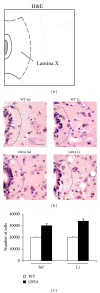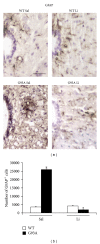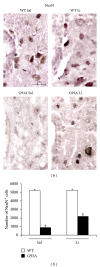Plastic changes in the spinal cord in motor neuron disease
- PMID: 24829911
- PMCID: PMC4009217
- DOI: 10.1155/2014/670756
Plastic changes in the spinal cord in motor neuron disease
Abstract
In the present paper, we analyze the cell number within lamina X at the end stage of disease in a G93A mouse model of ALS; the effects induced by lithium; the stem-cell like phenotype of lamina X cells during ALS; the differentiation of these cells towards either a glial or neuronal phenotype. In summary we found that G93A mouse model of ALS produces an increase in lamina X cells which is further augmented by lithium administration. In the absence of lithium these nestin positive stem-like cells preferentially differentiate into glia (GFAP positive), while in the presence of lithium these cells differentiate towards a neuron-like phenotype ( β III-tubulin, NeuN, and calbindin-D28K positive). These effects of lithium are observed concomitantly with attenuation in disease progression and are reminiscent of neurogenetic effects induced by lithium in the subependymal ventricular zone of the hippocampus.
Figures









References
-
- Han Q, Feng J, Qu Y, et al. Spinal cord maturation and locomotion in mice with an isolated cortex. Neuroscience. 2013;253:235–244. - PubMed
-
- Bradley WG. Recent views on amyotrophic lateral sclerosis with emphasis on electrophysiological studies. Muscle and Nerve. 1987;10(6):490–502. - PubMed
-
- Vogt T, Nix WA. Functional properties of motor units in motor neuron diseases and neuropathies. Electroencephalography and Clinical Neurophysiology. 1997;105(4):328–332. - PubMed
-
- Kim SU, Lee HJ, Kim YB. Neural stem cell-based treatment for neurodegenerative diseases. Neuropathology. 2013;33(5):491–504. - PubMed
Publication types
MeSH terms
Substances
LinkOut - more resources
Full Text Sources
Other Literature Sources
Miscellaneous

